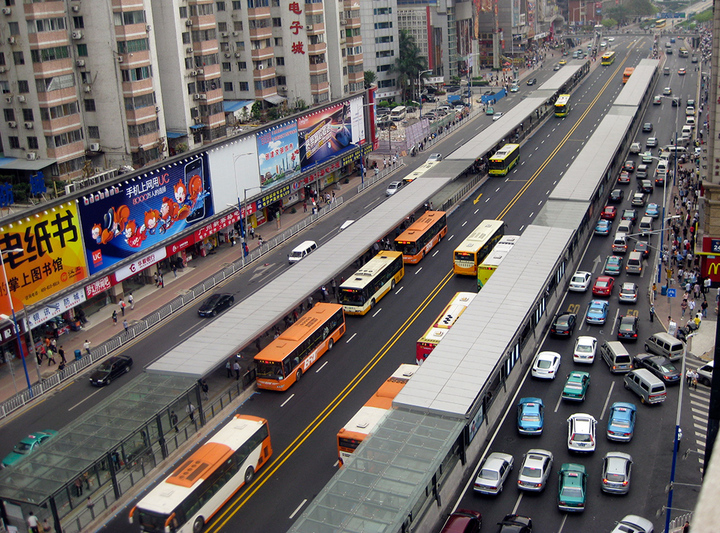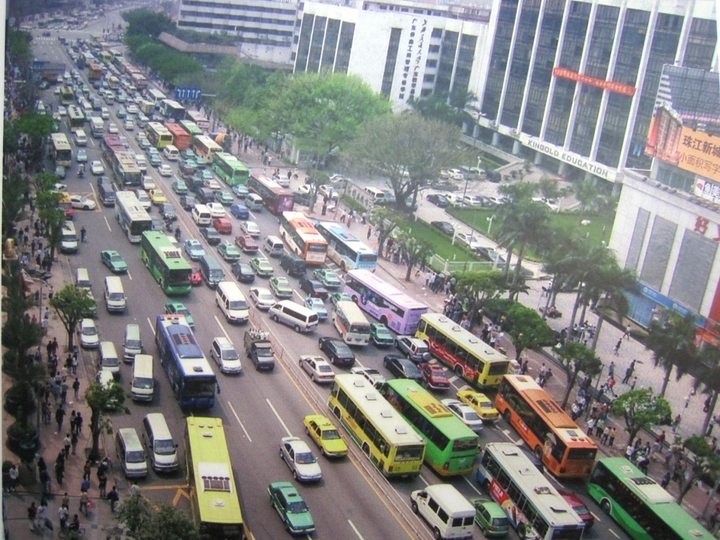Recently-Opened Bus Rapid Transit Line in Guangzhou, China: A Success
By Ferrol Robinson, Research Fellow, Humphrey Institute
With a population of over 10 million people, a fast-growing economy (over 12 percent in 2007-2008), and an astonishing 18 percent increase in private-car ownership during the same period, Guangzhou is experiencing severe levels of congestion that threaten the city's economic growth as well as its air quality.
Transportation officials in the City of Guangzhou are working hard to remedy this situation: First, with the expansion of the Metro subway system from its current five lines to nine in advance of the Asian Games being hosted by the city this year. Second, and after a relatively short planning and construction period, the city, under the Mayor's leadership, has just inaugurated a world-class Bus Rapid Transit (BRT) system (on February 10, 2010). Finally, the city has just held an "International Symposium on Analysis and Countermeasures of Traffic Congestion in Urban Centers" (March 8-9, 2010), with invited experts in congestion pricing from the U.S. and the U.K., as well as domestic transportation experts.
This article focuses on the BRT system. Information used in the description that follows was kindly provided by staff from the Institute for Transportation & Development Policy--ITDP. However, the commentary reflects my own understanding of the system.
The BRT route, which runs east-west along Tranhe Avenue, eastward from downtown, is a four-lane facility in the middle of what was an eight-lane expressway, in a 200-foot right-of-way. To accommodate the BRT design, the general-purpose lanes were reduced from eight to six (three lanes per direction), and additional space was taken from sidewalks, parking and green space. The result was four lanes of BRT (two lanes per direction), each 11.5 feet wide, compared to 10.2 feet for traffic lanes.
The BRT line is 14.3 miles long and has 26 stations, which are 13 to 16 feet wide and are located opposite each other. Stations are approximately 950 feet in length and can be accessed by means of pedestrian bridges, with stairs leading to the platforms. The covered stations are attractive, spacious, and are accessed through turnstiles. Passengers wait for their bus behind glass gates that open automatically when buses arrive. Bus access is level with station platforms and fare-prepayment is required. A total of 5,500 bicycle parking stalls are integrated into stations.
Thirty-one bus routes serve the BRT corridor, with a total of 310 buses per hour per direction (equivalent to about 12-second headways at the maximum bus-volume point). One route serves the corridor from beginning to end, while others act as feeders and operate in portions of the corridor only. At the beginning of March, 2010, four weeks after BRT opened for service, ridership had reached more than 800,000 passengers per day or about 25,000 passengers per hour per direction. This level of BRT ridership compares to 1.8 million riders carried by the five existing Metro subway lines. An important design feature is that three BRT stations are connected directly via tunnels to Metro stations. To introduce the public to BRT, the service was offered fare-free during the first two weeks of operation. After that, fares were set at 2 Yuan (about $0.30). In addition, a 40 percent discount is offered after 15 trips are made.
The unquestionable success of the BRT line has come at a price: Passengers are experiencing crush loads (110 passengers per bus, or over 1.3 passengers per square foot). This has led to a decision to soon replace the 40-foot buses with 60-footers. These oversaturated levels of demand have also resulted in average peak-period loading times in excess of one minute, despite fare prepayment and easy access.
The total cost of the BRT system is estimated by the ITDP at $441 million ($31 million per mile), including stations, bridges, system controls, road reconstruction, etc.
During the design and public consultation period, there was substantial opposition to the idea of taking lanes from an already-congested expressway, and many predicted a worsening congestion problem. These fears and concerns have largely died away in light of BRT's high use and popularity and, rather than worsening congestion in the general-purpose lanes, auto speeds are reported to have increased. This can be understood by examining before and after traffic operations on the expressway. If one looks at the four general-purpose lanes in the peak direction before BRT, buses are double parked as they drop off and take on passengers, and occupy at least two of the four lanes available. In addition, buses further interfere with the flow of general traffic when they use a third lane to merge as they leave the bus stops. The resulting traffic condition is quite chaotic and "turbulent", where autos have, in effect, fewer than two lanes available for travel. In the with-BRT situation, buses are segregated from the general traffic, resulting in an orderly, "laminar" flow, where autos have fully three lanes at their disposal. While the general-purpose lanes remain congested, the improvement in flow explains why--with fewer lanes available--congestion in the general-purpose lanes has eased, as revealed by higher traffic speeds. Another contributing factor to the speed increase may have been a mode shift from auto to BRT, because of BRT's better level of service.
With BRT

Construction of the BRT line and expansion of the Metro system are substantial and important first steps in implementing countermeasures to deal with the city's current and future congestion problems. However, as discussed at the Guangzhou symposium, and given the city's steep rate of economic and vehicular growth, it is going to be very difficult, if not impossible, for the city to "build itself out of congestion", whether through such well-executed transit expansions as the BRT system, or through additional highway expansion. As the City of Guangzhou continues to explore other options, it is important that it give serious consideration to congestion pricing. The bundling of congestion pricing, transit and other demand management countermeasures is considered to offer the best results for managing and reducing congestion and energy consumption, as well as for improving accessibility and air quality.
